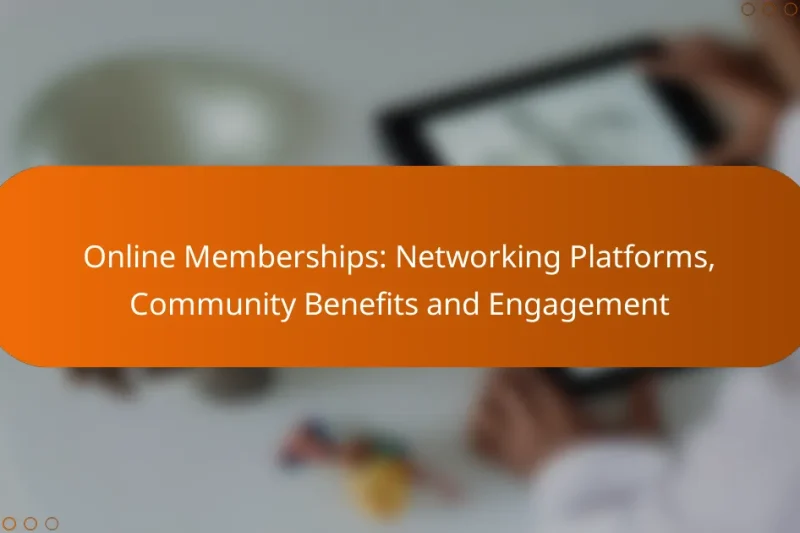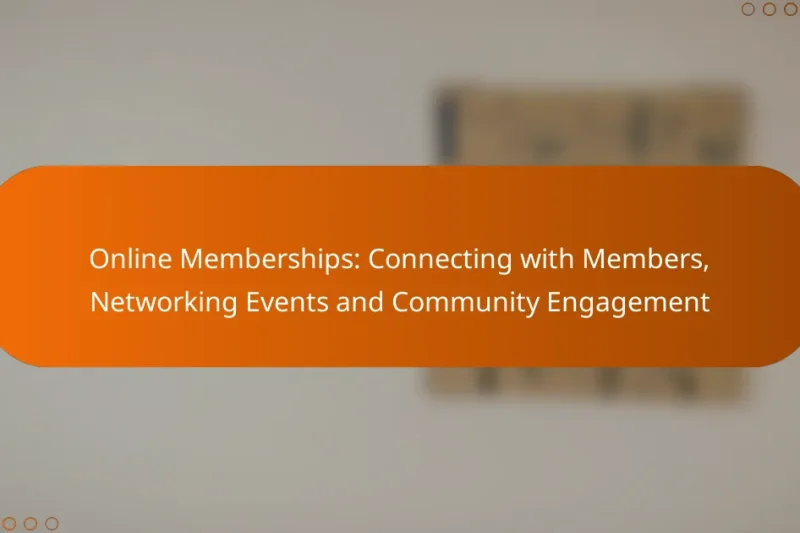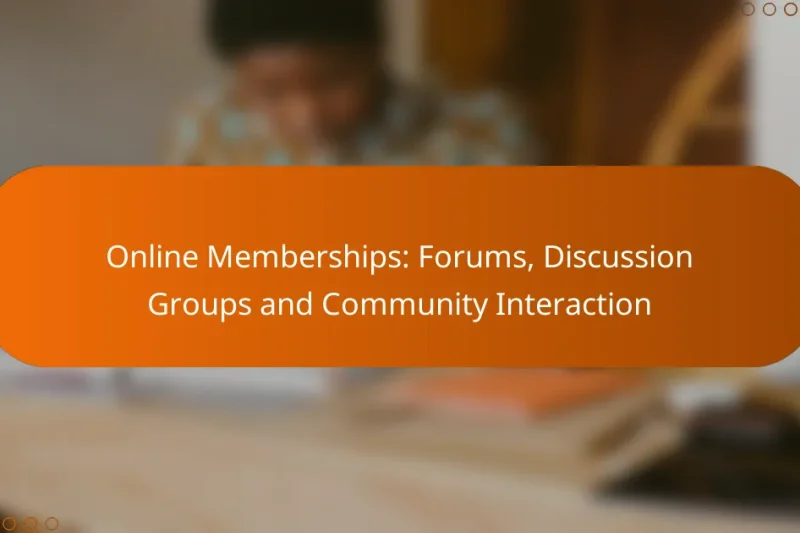Online memberships serve as powerful networking platforms that connect individuals across various professional fields, enhancing collaboration … Online Memberships: Networking Platforms, Community Benefits and EngagementRead more
Community and Networking Opportunities
Community and networking opportunities play a crucial role in professional development, offering avenues to connect with peers and industry leaders. By participating in local meetups, professional associations, and tailored networking events, individuals can enhance their career prospects and gain access to valuable resources. Engaging actively in these communities fosters collaborations and mentorships that can significantly impact your career trajectory.
Online Memberships: Professional Growth, Networking Opportunities and Community Resources
Online memberships are a powerful tool for professional growth, offering access to essential resources, networking opportunities, … Online Memberships: Professional Growth, Networking Opportunities and Community ResourcesRead more
Online Memberships: Local Networking, Community Engagement and Member Connections
Online memberships serve as a powerful tool for enhancing local networking by bringing together individuals with … Online Memberships: Local Networking, Community Engagement and Member ConnectionsRead more
Online Memberships: Connecting with Members, Networking Events and Community Engagement
Online memberships offer a powerful way to enhance community engagement by connecting members and providing access … Online Memberships: Connecting with Members, Networking Events and Community EngagementRead more
Online Memberships: Building Relationships, Networking Strategies and Community Support
Online memberships are a powerful way to cultivate relationships and foster community support among members. By … Online Memberships: Building Relationships, Networking Strategies and Community SupportRead more
Online Memberships: Participating in Events, Networking Opportunities and Community Growth
Online memberships provide a powerful platform for enhancing event participation, offering exclusive access to resources and … Online Memberships: Participating in Events, Networking Opportunities and Community GrowthRead more
Online Memberships: Forums, Discussion Groups and Community Interaction
Online memberships play a crucial role in enhancing community interaction by offering dedicated platforms where members … Online Memberships: Forums, Discussion Groups and Community InteractionRead more
What are the best community and networking opportunities in major cities?
The best community and networking opportunities in major cities often include local meetup groups, professional associations, and networking events tailored to specific industries. Engaging in these activities can significantly enhance your professional connections and provide valuable resources for career growth.
Meetup groups in New York City
New York City offers a vibrant array of meetup groups catering to various interests and professional fields. Groups such as Tech in NYC and NYC Entrepreneurs provide platforms for networking, skill-sharing, and collaboration among like-minded individuals.
To find a suitable meetup, visit platforms like Meetup.com and filter by your interests. Consider attending events regularly to build relationships and stay updated on industry trends.
Professional associations in Los Angeles
Los Angeles is home to numerous professional associations that facilitate networking and professional development. Organizations like the Los Angeles Chamber of Commerce and the California Society of CPAs offer events, workshops, and resources for members.
Joining these associations can provide access to exclusive networking events and industry insights. Membership fees vary, so evaluate the benefits against the costs to ensure it aligns with your professional goals.
Local networking events in Chicago
Chicago hosts a variety of local networking events, often organized by industry-specific groups or chambers of commerce. Events like the Chicago Networking Group and various industry expos allow professionals to connect and exchange ideas.
To maximize your experience, prepare an elevator pitch and bring business cards. Aim to follow up with new contacts within a week to solidify connections.
Online communities for remote professionals
For remote professionals, online communities offer valuable networking opportunities without geographical constraints. Platforms like LinkedIn Groups, Remote Work Hub, and Slack communities provide spaces for sharing resources and connecting with peers.
Engage actively in discussions and contribute your expertise to build your reputation. Look for virtual events or webinars hosted by these communities to expand your network further.
How can I leverage membership platforms for networking?
Membership platforms offer valuable networking opportunities by connecting you with like-minded professionals and industry experts. Engaging actively in these communities can lead to collaborations, mentorships, and career advancements.
Benefits of joining LinkedIn groups
LinkedIn groups provide a focused environment for professionals to share insights, ask questions, and network. By joining relevant groups, you can access industry-specific discussions and connect with potential employers or collaborators.
Participating in these groups can enhance your visibility and credibility. Regular contributions can position you as a thought leader, making it easier to build relationships with other members.
Using Slack communities for professional growth
Slack communities facilitate real-time communication and collaboration among members. These platforms often host channels dedicated to specific topics, allowing for targeted discussions and networking opportunities.
Engaging in Slack communities can lead to immediate feedback and support from peers. Consider actively participating in discussions, sharing resources, and attending virtual events to maximize your professional growth.
What are the key criteria for selecting a networking group?
When selecting a networking group, consider factors such as relevance to your industry, member engagement levels, and the group’s overall reputation. These criteria help ensure that the connections you make are valuable and aligned with your professional goals.
Relevance to industry
The relevance of a networking group to your industry is crucial for meaningful connections. Look for groups that focus on your specific field, whether it’s technology, healthcare, finance, or another sector. This alignment increases the likelihood of finding peers who share similar challenges and opportunities.
To assess relevance, research the group’s mission and the backgrounds of its members. A group that regularly hosts industry-specific events or discussions can provide insights and connections that are directly applicable to your work.
Member engagement levels
High member engagement levels indicate a vibrant networking group where members actively participate and share resources. Look for groups that encourage interaction through regular meetings, online forums, and collaborative projects. Engaged members are more likely to provide support and referrals.
Evaluate engagement by attending a few meetings or events to gauge participation. If members are actively discussing topics and sharing experiences, it’s a sign of a healthy network. Conversely, low engagement might suggest a lack of interest or value, making it less beneficial for your networking efforts.
What are the top online networking platforms?
The top online networking platforms include LinkedIn, Facebook groups, and Discord. Each platform serves different purposes and communities, making it essential to choose the right one based on your networking goals.
LinkedIn for professional connections
LinkedIn is the leading platform for building professional connections and showcasing your career. Users can create detailed profiles, connect with colleagues, and join industry-specific groups to engage with like-minded professionals.
To maximize your LinkedIn experience, regularly update your profile, share relevant content, and participate in discussions. Consider sending personalized connection requests to expand your network effectively.
Facebook groups for niche interests
Facebook groups provide a space for individuals with specific interests to connect and share knowledge. These groups can range from professional networks to hobbyist communities, allowing for diverse interactions.
When joining Facebook groups, look for those with active members and regular posts. Engage by asking questions, sharing insights, and participating in group events to build relationships and gain visibility.
Discord for tech communities
Discord is popular among tech enthusiasts and gaming communities, offering real-time communication through voice, video, and text channels. It allows users to join servers dedicated to specific topics or interests, fostering collaboration and networking.
To effectively use Discord, find servers that align with your interests and actively participate in discussions. Utilize voice channels for direct conversations and consider hosting events or workshops to engage with the community.
How can I measure the effectiveness of my networking efforts?
To measure the effectiveness of your networking efforts, track both the quantity and quality of connections made. Consider metrics such as referral sources, connection quality, and follow-up outcomes to assess your networking impact.
Tracking referral sources
Tracking referral sources involves identifying where your connections originate. This can include direct referrals from colleagues, introductions through mutual contacts, or leads generated from networking events. Keeping a record of these sources helps you understand which channels yield the most valuable connections.
To effectively track referral sources, maintain a simple spreadsheet or use a CRM tool. Note the name of the referrer, the date of the introduction, and any follow-up actions taken. This practice allows you to identify patterns and focus on the most productive networking avenues.
Evaluating connection quality
Evaluating connection quality means assessing the strength and relevance of your networking relationships. Consider factors such as the depth of interaction, mutual benefits, and the potential for collaboration. High-quality connections often lead to more significant opportunities and support.
To gauge connection quality, regularly engage with your network through follow-ups or meetings. Ask for feedback on your interactions and be open to providing value in return. A good rule of thumb is to prioritize relationships that demonstrate reciprocity and align with your professional goals.
What are emerging trends in community building?
Emerging trends in community building focus on inclusivity, digital engagement, and hybrid models that blend online and offline interactions. These trends emphasize creating spaces where diverse voices can be heard and where technology enhances connectivity among members.
Increased Focus on Inclusivity
Communities are increasingly prioritizing inclusivity to ensure that all members feel welcome and valued. This involves actively seeking out diverse perspectives and creating environments that cater to various backgrounds and experiences. For example, community leaders might implement policies that encourage participation from underrepresented groups.
To foster inclusivity, consider hosting events that celebrate different cultures or perspectives. Providing resources in multiple languages can also help bridge gaps and make participation easier for everyone.
Digital Engagement Strategies
Digital engagement has become a cornerstone of community building, especially with the rise of social media and online platforms. Communities are leveraging these tools to facilitate discussions, share resources, and organize events. Utilizing platforms like Discord or Slack can enhance real-time communication among members.
When implementing digital strategies, ensure that the platforms chosen align with your community’s demographics. For instance, younger audiences may prefer Instagram or TikTok, while older members might gravitate towards Facebook or email newsletters.
Hybrid Community Models
Hybrid community models combine online and offline interactions to maximize engagement and accessibility. This approach allows members to connect in person while also providing virtual options for those who cannot attend physically. For example, a local book club might meet monthly in a café but also host virtual discussions via Zoom.
To successfully implement a hybrid model, invest in technology that supports both formats, such as high-quality video conferencing tools. Additionally, ensure that in-person events are designed to be inclusive of online participants, perhaps by incorporating live chats or Q&A sessions.






